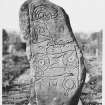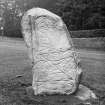Following the launch of trove.scot in February 2025 we are now planning the retiral of some of our webservices. Canmore will be switched off on 24th June 2025. Information about the closure can be found on the HES website: Retiral of HES web services | Historic Environment Scotland
Dunnichen
Pictish Symbol Stone (7th Century)
Site Name Dunnichen
Classification Pictish Symbol Stone (7th Century)
Canmore ID 34684
Site Number NO54NW 3
NGR NO 516 496
NGR Description NO c. 516 496
Datum OSGB36 - NGR
Permalink http://canmore.org.uk/site/34684
- Council Angus
- Parish Dunnichen
- Former Region Tayside
- Former District Angus
- Former County Angus
Dunnichen, Angus, Pictish symbol stone
Measurements: H more than 1.4m, W 0.7m, D 0.21m
Stone type: Old Red Sandstone
Place of discovery: NO 516496
Present location: Meffan Museum, Forfar
Evidence for discovery: said to have been found during ploughing in 1811 on the Dunnichen estate, it was erected first at the Kirkton at Dunnichen and then in the late nineteenth century in the garden of Dunnichen House. Around 1967 it was taken to the museum at St Vigeans and in 1972 transferred to Dundee Museum and Art Gallery. A replica stands on the village green at Dunnichen.
Present condition: good
Description
A large undressed slab incised on one face with the flower symbol, an ornate double disc and Z-rod symbol, and a mirror and single-sided comb. The double discs contain running spirals.
Date range: seventh century.
Primary references: Chalmers 1848, pl 14; ECMS pt 3, 206-7; RCAHMS 2003.
Compiled by A Ritchie 2016
Dunnichen, Angus, Pictish symbol stone
Measurements: H more than 1.4m, W 0.7m, D 0.21m
Stone type: sandstone
Place of discovery: NO 516496
Present location: The Meffan Institute, Forfar.
Evidence for discovery: said to have been found during ploughing in 1811 on the Dunnichen estate, it was erected first at the Kirkton at Dunnichen and then in the late nineteenth century in the garden of Dunnichen House. Around 1967 it was taken to the museum at St Vigeans and in 1972 transferred to the museum in Dundee and subsequently to Forfar. A replica stands on the village green at Dunnichen.
Present condition: good
Description
A large undressed slab incised on one face with the flower symbol, an ornate double disc and Z-rod symbol, and a mirror and single-sided comb. The double discs contain running spirals.
Date range: seventh century.
Primary references: Chalmers 1848, pl 14; ECMS pt 3, 206-7; RCAHMS 2003.
Desk-based information compiled by A Ritchie 2018
NO54NW 3 516 496.
(NO 5082 4883) Standing Stone (NAT)
OS 6" map, (1959)
A Class I symbol stone: a rough sandstone pillar, 4'8" high, 2'3" wide and 1' thick, sculptured on one face with incised symbols which include the 'flower', double-disc, Z-rod, 'mirror', and 'comb'. On each face of the stone there are grooves and holes which do not seem to have formed part of the original design.
The stone was ploughed up in 1811 in a field named 'Chashel' or 'Castle' Park on the terrace N of the site of 'Nechtansmere' and on the farm of East Mains of Dunnichen at a spot now occupied by a quarry. Immediately below the stone, a "stone coffin" containing bones was found (Jervise 1858).
The symbol stone was removed first to a site at Kirkton, near the church, then to its present position in the garden of Dunnichen House.
J R Allen and J Anderson 1903; A Jervise 1859; New Statistical Account (NSA) 1845; A J Warden 1880-5.
Field Visit (11 May 1966)
This stone, as described, still stands in the garden of Dunnichen House. Enquiries at East Mains of Dunnichen failed to locate the field 'Chashel' or 'Castle' Park, but there is an old quarry on the OS 25" map at NO 5165 4960. Enquiries also failed to locate the name 'Kirkton', but the Rev J M Black, Dunnichen Manse, suggests that it may have been 'Kirkden' church (NO 5316 4850).
Visited by OS (WDJ) 11 May 1966.
Field Visit (6 November 1967)
This symbol stone was removed c.January 1967 to the museum at St Vigeans, Arbroath.
Visited by OS field Surveyor 6 November 1967.
Note (1978)
Dunnichen 2 NO c. 515 493 NO54NW 3
In 1811 a fine Class 1 symbol stone was ploughed up in a field called the Castle Park on the farm of East Mains of Dunnichen. In addition to the 'flower', the double disc and 2-rod, and the mirror and comb symbols, there are two grooves, one on each side of the decorated face, which appear to post-date the incised designs. In view of the fact that a cist containing some bones was found beneath the stone, it is possible that the two grooves represent the preparation of the slab for re-use as a cist cover. The stone is now in the St Vigeans Museum.
RCAHMS 1978
(NSA, xi, Forfar, 146; Jervise 1857, 189; Allen and Anderson 1903, iii, 206-7; Coutts 1970, 57, no. 11)
External Reference (2 June 1980)
The symbol stone was moved to Dundee Museum in 1972 where it is on display, and a replica has been set up on the green in front of Dunnichen Church. (See NO43SW 91.1.)
Information contained in letter from L Thoms, Dundee Museum 2 June 1980.
Reference (1997)
Class I symbol stone showing a vertical arrangement of a flower above a double-disc and Z-rod and mirror-and-comb.
A.Mack 1997


















































